Kitbull (2019)
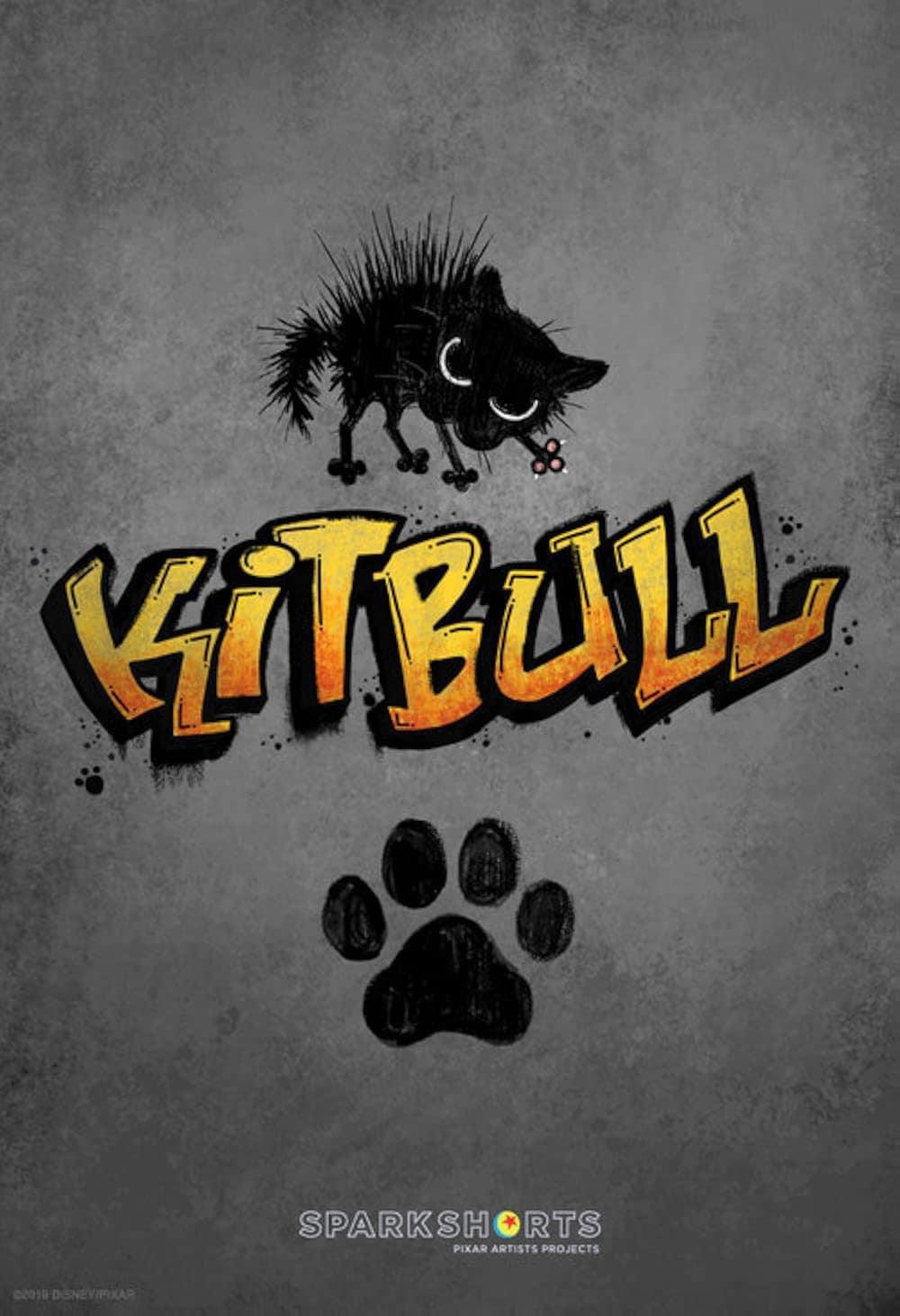
Kitbull (2019) is a beautifully crafted, emotionally stirring animated short film by Pixar, directed by Rosana Sullivan and produced by Kathryn Hendrickson as part of Pixar’s SparkShorts program. Unlike Pixar’s traditional 3D animation style, Kitbull uses 2D animation, bringing a hand-drawn feel that amplifies its raw, touching story. This short film, which runs just under nine minutes, explores themes of friendship, trauma, and resilience through the unlikely bond between a stray kitten and an abused pit bull.
Suggested videos for you:
Plot Summary
Set in a gritty urban neighborhood, Kitbull follows a skittish, independent black kitten who lives alone in a cardboard box, scavenging for food and cautiously navigating the dangerous streets. One day, a pit bull is chained up in the nearby yard, and despite initial mistrust, the kitten slowly begins to interact with him. Initially, the kitten is terrified of the dog, misunderstanding his attempts at friendship as threatening gestures.
Over time, the two animals start to form a bond. They play, explore, and share brief moments of connection that break through the barriers of fear and distrust. However, the pit bull’s life is a harsh one; he’s neglected, abused, and even forced to fight, which is painfully revealed in a heartbreaking scene where he returns with scars and injuries. The kitten’s innate compassion leads it to try to comfort the pit bull, sharing a tender moment that’s at once heart-wrenching and hopeful. Eventually, the kitten finds the courage to help the pit bull escape his captivity, and they both find their way to a new, caring home together.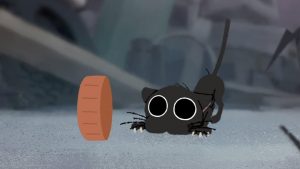
Animation Style and Visuals
Kitbull marks a departure from Pixar’s typical 3D animation style, embracing a hand-drawn, 2D approach that feels warm and accessible. The animation style brings a storybook quality to the short, making it immediately stand out from Pixar’s other works. The characters’ movements are expressive yet simple, capturing subtle emotions without the need for dialogue. Every flick of the kitten’s tail, every tentative paw step, and every glance carries meaning, making their personalities shine.
The use of light and color in Kitbull is also striking. The film shifts between the harsh shadows and muted grays of the cityscape to softer, more vibrant hues during the moments of warmth and connection between the kitten and the pit bull. The lighting and shading help convey the story’s emotional tone, from the loneliness and fear the animals initially experience to the warmth and hope that arise as they grow closer.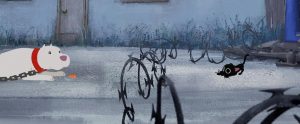
Themes and Emotional Depth
At its heart, Kitbull is a story about empathy, resilience, and healing. It explores how creatures, even ones who have faced neglect and abuse, can find comfort in each other and forge bonds that transcend fear and prejudice. The film is particularly powerful in its portrayal of the pit bull, a breed that’s often stereotyped and misunderstood. Through his gentle, hopeful demeanor, we see a tender side of the pit bull that contrasts with his harsh treatment, shedding light on the cruelty of breed discrimination and the effects of abuse.
The kitten’s journey from self-preservation to compassion is another moving aspect of the story. Initially self-centered and wary, the kitten learns to overcome its fear and reach out to the pit bull, symbolizing the power of empathy. This shift speaks to the idea that healing can come from kindness and connection, even in the darkest of circumstances. The pit bull’s transformation—from a beaten-down animal to a hopeful companion—speaks volumes about resilience and the desire for connection, regardless of past pain.
Without any dialogue, Kitbull also communicates universal themes about friendship, bravery, and the healing power of companionship. By showcasing the lives of animals often overlooked or mistreated, the film advocates for animal welfare and challenges viewers to consider the plight of abandoned or abused pets.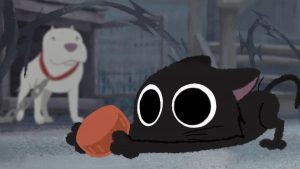
Direction and Storytelling
Rosana Sullivan’s direction is sensitive and thoughtful, allowing the story to unfold at a measured, quiet pace that draws viewers into the world of the kitten and pit bull. Each frame is carefully constructed to convey emotion, and Sullivan’s use of visual storytelling is powerful, conveying complex feelings without a single line of dialogue. Sullivan’s background as a story artist is evident in the film’s narrative flow, with every small interaction between the kitten and pit bull adding layers to their relationship.
The pacing of Kitbull is also a standout element. The film doesn’t rush to establish the bond between the animals but instead lets it develop organically, capturing the slow progression from distrust to friendship. This approach makes their bond feel genuine and emphasizes the importance of patience and understanding in relationships, especially those that grow out of painful circumstances.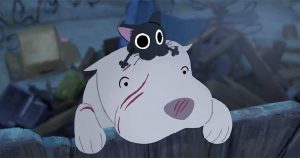
Music and Sound Design
The score by composer Andrew Jimenez is gentle and unobtrusive, accentuating the film’s emotional beats without overwhelming them. The music swells subtly during moments of tension or warmth, amplifying the characters’ feelings in ways that deepen the story. The sound design is also crucial; the ambient sounds of the city, the scratching of the kitten’s claws, the jingling of the pit bull’s chain—all contribute to a visceral sense of place and emotion. These sounds heighten the film’s realism, making the characters’ world feel lived-in and authentic.
Social Message and Impact
Beyond its storytelling, Kitbull carries a powerful social message about animal welfare, addressing issues like neglect, abuse, and stereotypes surrounding certain animal breeds. The short humanizes animals in a way that invites viewers to empathize deeply with them, making it clear that animals, like humans, are capable of feeling pain, loneliness, and the need for love. By casting a pit bull as one of the central characters, Kitbull challenges harmful stereotypes, urging viewers to see beyond breed bias and recognize the potential for kindness and gentleness in all creatures.
Since its release, Kitbull has resonated deeply with audiences, receiving praise for its emotional depth and impactful message. It has raised awareness about animal abuse and encouraged conversations around compassion and understanding for animals, particularly those who may be misunderstood or mistreated.
Verdict
Kitbull is a masterfully crafted short film that combines Pixar’s storytelling prowess with a fresh, heartfelt approach to animation. It’s a poignant, unforgettable story that leaves a lasting impact despite its brief runtime. By focusing on the innocent bond between two creatures struggling to survive in a harsh world, Kitbull emphasizes the healing power of empathy, compassion, and friendship. Its universal themes, unique animation style, and powerful social message make it a standout piece of animation that appeals to viewers of all ages.
While simple in its premise, Kitbull packs an emotional punch that lingers long after the credits roll. It’s a testament to the power of animation to tell meaningful stories and to Pixar’s ability to explore new creative paths with sensitivity and depth. For anyone who appreciates heartfelt, beautifully crafted storytelling, Kitbull is a must-watch—a small story with a big heart that celebrates the resilience and warmth that connection can bring to even the most unlikely of friends.








